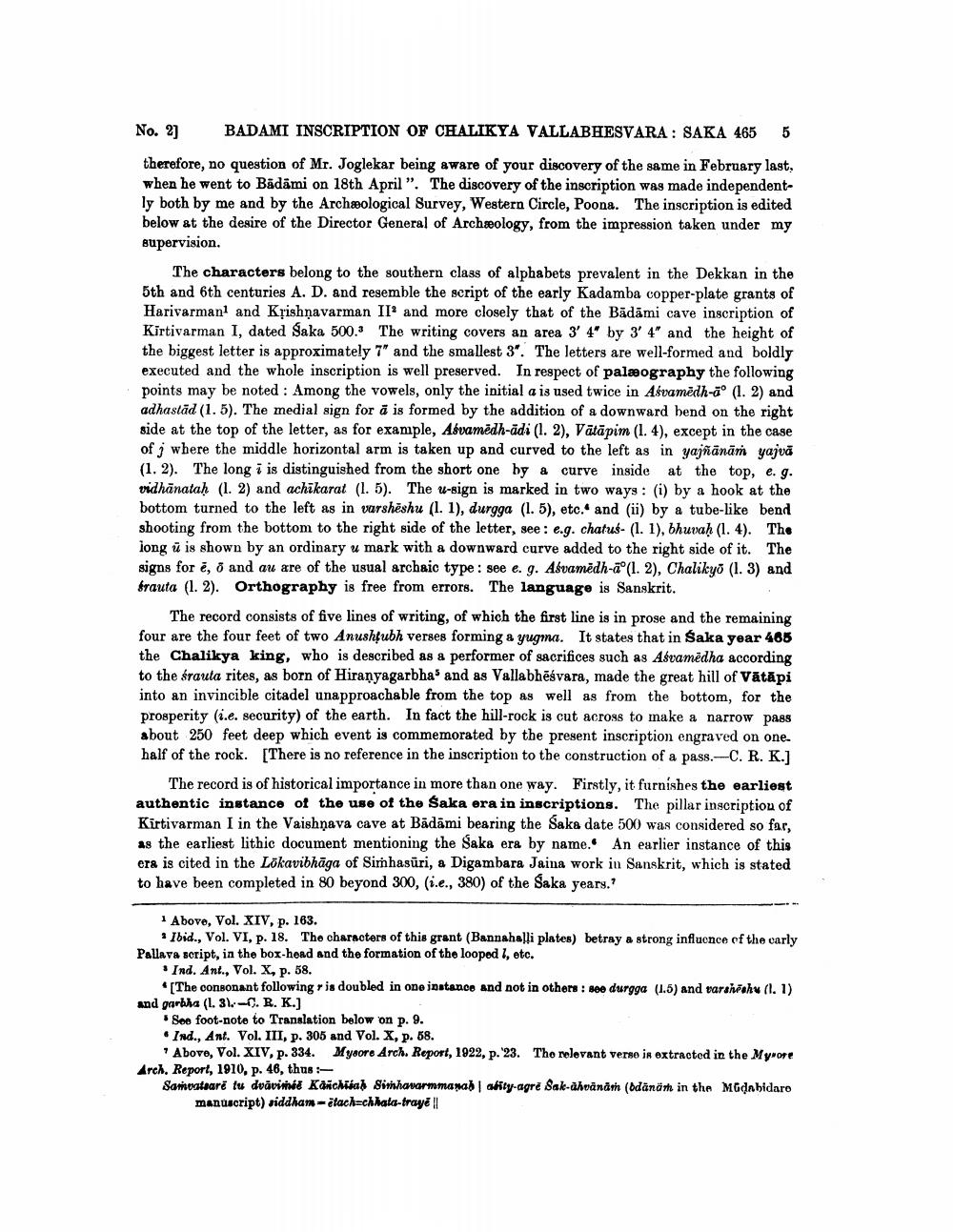________________
No. 2) BADAMI INSCRIPTION OF CHALIKYA VALLABHESVARA : SAKA 4655 therefore, no question of Mr. Joglekar being aware of your discovery of the same in February last, when he went to Badami on 18th April". The discovery of the inscription was made independently both by me and by the Archeological Survey, Western Circle, Poona. The inscription is edited below at the desire of the Director General of Archæology, from the impression taken under my supervision.
The characters belong to the southern class of alphabets prevalent in the Dekkan in the 5th and 6th centuries A. D. and resemble the script of the early Kadamba copper-plate grants of Harivarman and Krishnavarman II and more closely that of the Bädāmi cave inscription of Kirtivarman I, dated Saka 500. The writing covers an area 3' 4" by 3' 4" and the height of the biggest letter is approximately 7" and the smallest 3". The letters are well-formed and boldly executed and the whole inscription is well preserved. In respect of palæography the following points may be noted : Among the vowels, only the initial a is used twice in Asvamēdh-ū° (1.2) and adhastād (1.5). The medial sign for å is formed by the addition of a downward bend on the right side at the top of the letter, as for example, Asvamëdh-ādi (1.2), Vätāpim (1.4), except in the case of j where the middle horizontal arm is taken up and curved to the left as in yajñānāṁ yajvă (1.2). The long iis distinguished from the short one by a curve inside at the top, e.g. vidhānatah (1.2) and achikarat (1. 5). The u-sign is marked in two ways: (i) by a hook at the bottom turned to the left as in varshēshu (1.1), durgga (1. 5), etc. and (ii) by a tube-like bend shooting from the bottom to the right side of the letter, see: e... chatu - (1. 1), bhuvah (1.4). The long ū is shown by an ordinary u mark with a downward curve added to the right side of it. The gigns for e, o and au are of the usual archaic type : see e. g. Ašvamēdh-ā°(.2), Chalikyo (1.3) and frauta (1.2). Orthography is free from errors. The language is Sanskrit.
The record consists of five lines of writing, of which the first line is in prose and the remaining four are the four feet of two Anushtubh verses forming a yugma. It states that in Saka year 468 the Chalikya king, who is described as a performer of sacrifices such as Asvamëdha according to the Srauta rites, as born of Hiranyagarbha' and as Vallabhēsvara, made the great hill of Vātāpi into an invincible citadel unapproachable from the top as well as from the bottom, for the prosperity (i.e. security) of the earth. In fact the hill-rock is cut across to make a narrow pass about 250 feet deep which event is commemorated by the present inscription engraved on one. half of the rock. [There is no reference in the inscription to the construction of a pass.-C. R. K.]
The record is of historical importance in more than one way. Firstly, it furnishes the earliest authentic instance of the use of the Saka era in inscriptions. The pillar ingcription of Kirtivarman I in the Vaishnava cave at Bādāmi bearing the Saka date 500 was considered so far, as the earliest lithic document mentioning the Saka era by name. An earlier instance of this era is cited in the Lökavibhāga of Simhasūri, a Digambara Jaina work in Sanskrit, which is stated to have been completed in 80 beyond 300, i.e., 380) of the Saka yeary.?
1 Above, Vol. XIV, p. 163.
* Ibid., Vol. VI, p. 18. The characters of this grant (Bannahalli plates) betray a strong influence of the carly Pallava script, in the box-head and the formation of the looped I, etc.
Ind. Ant., Vol. X, p. 58.
* [The consonant following ris doubled in one instance and not in others : see durgga (1.5) and varshishu (1.1) and garbha (1. 31.-1). R. K.)
Soe foot-note to Translation below on p. 9. • Ind., Ant. Vol. III, p. 305 and Vol. X, p. 58.
Above, Vol. XIV, p. 334. Mysore Arch. Report, 1922, p. 23. Tho relevant verse is extracted in the Myrore Arch. Report, 1910, p. 46, thus - Samoatare tu dvavimid Kanchidah Simhawarmmanah ality-agre Sak-ahvänärh (Odänäth in the MGdabidaro
manuscript) siddham-etach=chhala-traye ||




